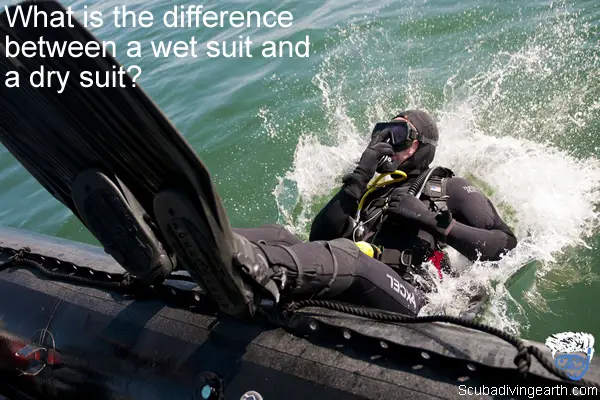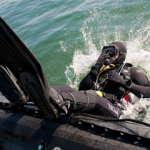
Cold water diving like the UK, do you use a wetsuit, semi dry suit or dry suit?
If you’ve only ever dived using a wetsuit. Or if you’ve not used either a semi drysuit or a drysuit. You maybe wondering what the difference is between these exposure suits for scuba divers. Alternatively, you may have been using a semi drysuit in the UK or other cold waters. Which means you may be considering the switch to a drysuit.
So what is the difference between a drysuit and a semi dry suit: Semi drysuits are used in cooler water temperatures than for a wetsuit, whereas drysuits are designed for even colder water temperatures. Drysuits have better and tighter fitting seals to keep the water out. Whereas semi drysuits have seals that are designed to flush water.
The best way to do more diving is to book yourself on a scuba diving liveaboard. You can check the latest and best deals on liveaboards using the following window:
What is a semi dry suit?
Semi dry suits are similar to a wetsuit. But the difference is the seals on a semi dry suit are similar to a drysuit, but they are designed to allow a small amount water in.
Semi dry-suits have ankle, wrist and neck seals designed to reduce the flushing effect of water. This is less when compared to how much water can flush through a wetsuit. The effect of less ‘flushing‘ of water means that less cold water enters.
Therefore a semi drysuit will keep you warmer than a wetsuit in colder waters.
Semi drysuits tend to be made from neoprene, just like wetsuits. But quite often a semi drysuit is a two piece suit and is thicker than a wetsuit.
The two pieces of a semi drysuit means there is a double layer of neoprene around your torso. The torso is the part of the body that needs to be kept the warmest.
One important difference is how tightly fitting a semi drysuit needs to be vs how tight a drysuit needs to be. So you may also like to read about how tight a drysuit should be. This article includes a drysuit fitting guide too and how to check whether it’s too tight before buying.
More Reading: Do You Wear Anything Under A Wetsuit? (What To Wear Male & Female)
Do semi drysuits keep you dry?
Semi drysuits work on a similar principle to wetsuits. They work by having warmth gained from a thin layer of water, which lies between the suit and the skin.
It is your body temperature that warms this thin layer of water up. Once warmed, it helps to keep you warm throughout your dive.
It is therefore the case that semi drysuits do not keep you dry. You are therefore wet when you finish your dive.

Do semi drysuits work?
Yes semi drysuits work well in waters that are too cold for a wetsuit to keep you warm. But where a semi drysuit lets you down is if you’re going to be doing a second dive. This is especially true on a cold day.
A semi drysuit out of water works in the opposite way to how it works underwater. If it’s a cold, wet and windy day and you’re on a dive boat, you’ll struggle to get warm in-between your dives.
When you get kitted up for your next dive and jump back into the cold sea, you’ll feel the cold much faster. When that fresh flush of cold water hits you, after never properly warming up, you may not be too happy. This means you’ll get colder much sooner.
You could opt to taking your semi drysuit off in-between your dives. But whilst this will help you to warm up on your dive interval, you’ve still got to get back into a wet and cold semi drysuit before your next dive.
It’s extremely unlikely it will dry out in-between your two dives.
What is a semi drysuit used for?
Semi drysuits are used for cold water dives in places like the Atlantic and North Sea around the UK, or in the colder waters around the Atlantic coast off the US. Or any other cold water dive sites around the world.
A semi drysuit is used when the water is too cold for a wetsuit.
Do semi drysuits keep you warm?
Yes semi drysuits will keep you almost as warm as a drysuit actually.
I dived for many years in UK waters using a semi drysuit. But as mentioned earlier, my only problem was the dive interval between dives.
It was only when a colleague convinced me to try out his drysuit. It was then that I switched to using a drysuit instead, and never looked back.
I even dived many times in a semi drysuit in the cold North Sea waters of the Farne Islands to dive with seals. I was as warm as all the divers who dive with me in dry suits on the first dive.
But in the boat and on the second dive is where there was a noticeable difference. After the first dive there was me struggling to get warm, whereas those divers in dry suits were toasty warm!
Can you swim in a semi drysuit?
A semi drysuit is not ideally designed for swimming. The reason for this is that the thicker neoprene makes it more difficult to use your arms in a swimming stroke. This is especially true if you are planning on swimming using the front crawl.
You are much better to use a wetsuit if you intend to swim and want to keep warm.
What is the difference between a wetsuit and a semi drysuit?
The main difference between a wetsuit and a semi drysuit include the following:
- The thickness of the neoprene – the neoprene on a semi drysuit is thicker than a wetsuit.
- A semi drysuit has different designed wrist, ankle and neck seals to reduce the water flushing effect compared to a wetsuit.
- A semi drysuit is more likely to be a two-piece suit to help add extra exposure insulation around the torso for warmth.
- Semi drysuits are more expensive than wetsuits.
- Semi drysuits are used more by scuba divers and less by other water users, whereas wetsuits are used across a whole range of water users. This includes surfers, snorkelers, free-divers, water skiers and swimmers.
Now that we’ve looked at what makes a semi-drysuit, let’s take a look at drysuits.
What is a drysuit?
A drysuit provides scuba divers with better thermal insulation than other exposure suits like wetsuits and semi dry suits, as the wearer is kept dry.
There are three types of drysuit. These include neoprene drysuits, crushed neoprene and membrane drysuits. Each one of these drysuits has it’s own properties and benefits or advantages vs its disadvantages over the other.
But all three types of drysuit described provide thermal protection at the same time as keeping the wearer dry.
More Reading: Does a dry suit keep you dry (What are the exceptions & do you get wet)
With a drysuit the thermal warmth is provided as follows:
- Neoprene drysuit. The thickness and thermal properties of neoprene keep you warm, together with the thin layer of air around your body inside the suit.
- Crush neoprene drysuit. It’s what you wear underneath this type of drysuit that will keep you warm, which is usually an undergarment called a woolly bear. This woolly bear together with the layer of air inside the suit keeps you warm. A ‘woolly-bear‘ is a effectively a thermal onesie.
- Membrane drysuit. The way this keeps you warm is similar to a crushed neoprene drysuit, which is by using a thermal garment under the membrane drysuit.
More Reading: At what temperature do I need a drysuit? (Drysuit temperature range)
Do drysuits keep you dry?
Drysuits are designed to keep you dry and they do. However, over time drysuits can spring a leak. Leaks can form around the wrist and neck seals or where the suit itself gets punctured.
It’s quite easy to have a drysuit repaired if it has a leak. But when you expect to be dry on a dive, it’s not a nice experience when you discover a leak when you’re underwater and cold water seeps in!
Do drysuits work?
Drysuits are designed to fit more loosely than wetsuits. They allow you to wear clothes and/or other insulation layers underneath, as explained above.
As describe previously, drysuits work by keeping an insulating layer of air between your body and the suit. It is this layer of air, combined with the insulating properties of either a neoprene drysuit or the thermal clothes under a crushed neoprene or membrane drysuit that makes it work well.
Drysuits work well in cold waters and can be used in freezing cold waters of the Arctic or Antarctic or perhaps when diving in a frozen lake.
The air in a drysuit is controlled using an inflator hose attached from your air supply to a valve on the suit. This inflator valve allows you to add air as you go deeper. This acts as your buoyancy control, instead of you using your buoyancy control device or BCD.
More Reading: How Does A Buoyancy Control Device Work? (Don’t Dive Without Knowing)
What is a dry suit used for?
As a general rule drysuits offer better insulation than wetsuits or semi drysuits. This is especially true when used in cold water and makes them more suitable for this type of use.
Drysuits are often used by commercial divers on oil rigs, by police divers who dive in cold rivers or lakes and by recreational scuba divers who dive in colder waters around the world.
But on the contrary, dry suits would be extremely uncomfortably in hot or warm climates and warm water. So you’d never consider using a drysuit in somewhere like the Caribbean or the Red Sea.
More Reading: EVERYTHING you need to know about drysuit diving (Ask the expert diver)
Typically drysuits are more expensive than wetsuits or drysuits. They are also a bit more complex to put on. They also require additional training before they can be used by scuba divers.
The extra training is because of the buoyancy qualities of a drysuit and the fact that when you’re drysuit-diving, the drysuit is used for buoyancy compensation rather than your BCD.
More Reading: How To Achieve Neutral Buoyancy Scuba Diving (Made Easy)
Do dry suits keep you warm?
Drysuits certainly keep you warm in cold water. But how warm you are when you’re using a drysuit depends on the amount of insulation you use. For example, with a neoprene drysuit, you’ll only be as warm as the thickness and thermal properties of the neoprene of the suit.
Whereas with a crushed neoprene and a membrane drysuit, you’re only as warm as the undergarments worn and their thermal properties.
The colder the water, the better the insulation is needed to compensation and to keep you warm when using a drysuit.
Can you swim in a dry suit?
Swimming in a dry suit would be quite challenging and is not generally something that is done. A drysuit is more restrictive for movement than a wetsuit is, as they are designed for comfort and warmth rather than for physical exertion
If you’re looking for thermal insulation for swimming, you’re better off using a wetsuit instead.
What do you wear under your drysuit?
As discussed earlier, with a crushed neoprene drysuit you wear warm insulating clothes. The same goes for a membrane drysuit. But for a neoprene drysuit you just wear shorts and a t-shirt.
In really cold weather and if the water temperature is really low, you’d be advised to wear two layers or better thermal insulation.
What causes dry suit squeeze?
As you dive deeper, the air inside your drysuit gets squeezed. As already mentioned, if you’re diving using a drysuit, you’re better to use the drysuit as your method to achieve neutral buoyancy than you are to use your buoyancy control device.
However, drysuit squeeze is caused on your descent. It is caused where you fail to add enough air to your drysuit during the descent. It’s not really a problem, and you soon notice it when you forget. You’ll feel it most beneath the valves and seams of the suit as these push against your skin.
To overcome dry suit squeeze is a simple matter of adding more air using the inflator hose.
More Reading: What causes dry suit squeeze? (How to prevent dry suit squeeze)
What’s the difference between a wetsuit and dry suit?
The difference between a wetsuit and a drysuit is not too different from the differences between a drysuit and a semi drysuit.
Where the main difference between a wetsuit and a semi drysuit is to do mostly with the thickness of the neoprene and the seals and amount of water flush.
More Reading: What is the difference between a wetsuit and a dry suit?
What is the difference between a drysuit and a semi dry suit
In summary, the easiest way to remember the difference between a semi drysuit and a dry suit is that a semi drysuits let water in, whereas a drysuit doesn’t.
But let’s list what are the main differences between a drysuit and a semi dry suit:
- Semi drysuits are used in cooler water temperatures than for a wetsuit, whereas drysuits are designed for even colder water temperatures.
- Drysuits have better and tighter fitting seals to keep the water out. Whereas semi drysuits have seals that are designed to flush water.
- Drysuits tend to be more expensive than semi drysuits.
- A drysuit is effectively used as your buoyancy control device, whereas a semi drysuit isn’t.
- Drysuits keep you warmer out of water and in-between dives compared to semi drysuits and wetsuits which tend not to.
- Drysuits tend to be made of heavier and stronger insulating materials to help keep the wearer dry and the water out.
I hope you enjoyed this article about what is the difference between a drysuit and a semi dry suit
I’d love to hear from you. Tell us about your adventures of diving and snorkeling, in the comments below. Please also share your photos. Either from your underwater cameras or videos from your waterproof Gopro’s!
If this article hasn’t answered all of your questions. If you have more questions either about snorkeling or types of scuba diving (or specifically about what is the difference between a drysuit and a semi dry suit), please comment below with your questions.
There will also be many more articles about scuba diving (and snorkeling) for you to read and learn about these fabulous sports.
Have fun and be safe!




